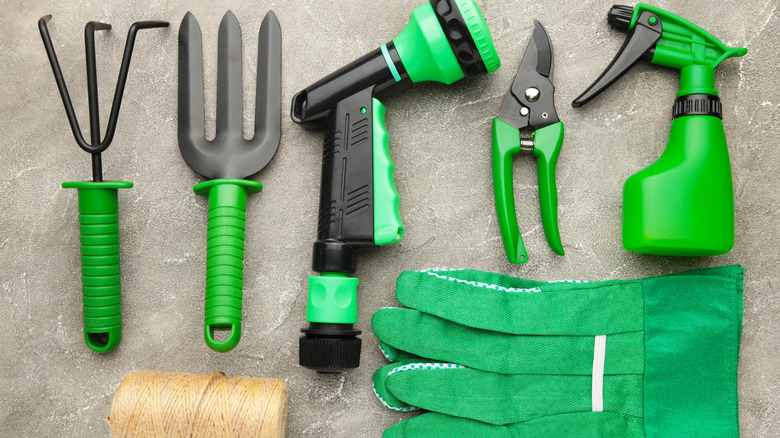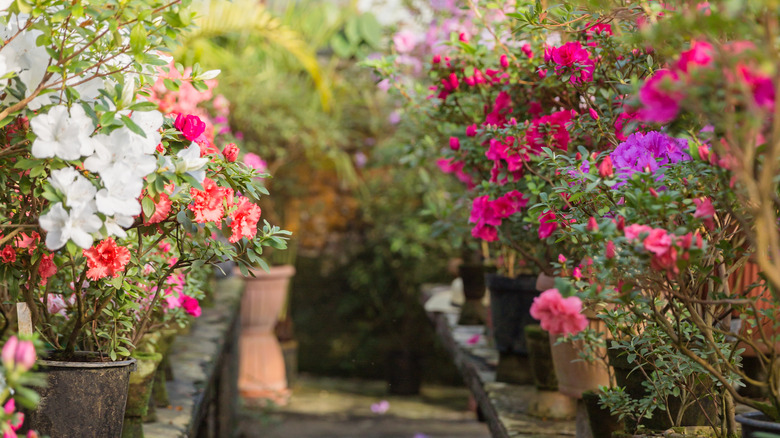Azaleas: Everything You Should Know Before Planting
Most people don't know that azaleas are a rhododendron, which is part of the heath family (Ericaceae), according to Britannica. These gorgeous shrubs come in a variety of colors and can be found in many different landscapes. They thrive in warmer climates and are a popular flower to grow in southern U.S. states (via Stauffers of Kissel Hill), although they are native to a few continents: Asia, Europe, and North America. The azalea bush draws the eye with its masses of bright, colorful flowers in shades of white, pink, yellow, red, purple, and orange. The flowers are tubular or funnel-shaped while the surrounding foliage is elliptical in shape, thin, and pliable, per Piedmont Master Gardeners. Keep in mind that azalea nectars and leaves are highly poisonous.
If you're a fan of azaleas, you'll be thrilled to learn that thousands of species are available commercially, offering you a variety of options when it comes to filling your garden. Because of this, you'll also want to do you research to make sure you're purchasing the right species for your space. While azaleas tend to average three-to-five feet in height and width, there are species that grow significantly smaller or larger. Azaleas also have sunlight requirements that you'll need to consider before purchasing: Morning sunlight and/or dappled afternoon shade tend to work best. Keep scrolling to learn more about growing this gorgeous shrub, also known as the "Royalty of the Garden."
How to use azaleas in the garden
Azaleas are great for adding pops of color to your garden. It can be a fantastic idea to place one in a shady spot where you don't get much light. You may also consider placing them along the curves of garden beds where they'll catch the eye when they bloom in the spring. If evergreen varieties are more your thing, the azalea shrub will provide structure to your garden, which you can design around. The great thing about azaleas is that they fill your garden with color in the spring and summer while also blending in well in the fall with their green leaves. You'll also want to use the size variation among azaleas to your advantage when designing your garden. Small shrubs are perfect for lining a garden bed or providing a foundation for other plants and flowers. Since different species of azalea have different bloom times, it can also be fun to plant azaleas in a tapestry design where they bloom sequentially.
The New York Botanical Garden offers suggestions for which plants combine best with azaleas in the garden. While deciduous azaleas look best planted next to other deciduous varieties and evergreens with other evergreens, azaleas also look great paired with woodland perennials, including ferns, wild ginger, hosta, and toad lily. Underplanting azaleas with spring bulbs, such as daffodils, is another way to enliven the color palette of your garden.
How to grow azaleas
Growing azaleas will depend on the variety you choose. However, the ideal time of year to plant them is in the late spring or early fall, as noted by The Old Farmer's Almanac. Once you've decided on a species and a location for your azaleas, you'll want to make sure the soil is conducive to planting this shrub. Soil acidity is incredibly important for azalea health and should not be too acidic. A pH between 4.5 and 6 is ideal. If you don't already have one, a soil acidity testing kit is a great investment.
While most azalea varieties will not need fertilizer to thrive, you'll need to make sure you provide a solid layer of mulch — this way, the azaleas get the nutrients they need and don't dry out as their roots spread out near the surface of the soil. An oak leaf mold, aged oak, pine needles, pine, or hemlock sawdust will make the best mulch for your azaleas.
Planting your azaleas is pretty straightforward; you'll first dig a hole that measures the same depth as the root ball of your azalea shrub (via Miracle Gro). Once you remove the plant from its vase and place it in the hole, the top of the root ball should not exceed the top of the soil line. Next, fill in the area surrounding the root ball with soil and top it off with a thick layer of mulch. Finish by watering your new plant.
How to care for azaleas
You'll be happy to know that azaleas are fairly easy to care for once they're planted. They dislike strong, direct sun, although they will tolerate the weaker morning sun (via Piedmont Master Gardeners). As far as watering goes, keep in mind that due to their shallow roots, azaleas need to be irrigated with a soaker hose or drip irrigation as opposed to watered overhead. While azaleas need consistent watering, as too much moisture can cause root disease. The mulch that you applied when you planted your azaleas should prevent the need for additional fertilizers, but a soil test will determine whether supplemental nutrition is indicated. If you need to add a bit of fertilizer to up your azaleas' nutrition intake, choose one made with ammonium nitrogen or cottonseed meal. Additionally, the best time of year to fertilize your azaleas is in the spring.
Azaleas can be prone to pests and disease, although planting and care practices should prevent these issues for the most part. Some diseases and pests you'll want to look out for include lacebugs, whiteflies, bark scale and azalea gall, as per Gardening Know How. In order to prevent pests and disease, make sure the soil is adequately acidic and nutrient dense and that you are not over or underwatering. You can also handpick infected leaves in the case of gall to avoid spread. One more point for proper upkeep of this plant is to prune after azaleas are done flowering.
Varieties of azaleas
There are over 10,000 different varieties of azaleas, which encompass both species and hybrids. The different species interbreed and reproduce separately from other populations while hybrids are humanmade crosses (via Azaleas). The result of all of these varieties is that you will have many different sizes, colors, shapes, and bloom times to choose from. Azaleas can also be deciduous or evergreen. Deciduous azaleas, which lose their leaves in the fall, grow in North America while evergreen azaleas, which keep their leaves year-round, are native to Asia, primarily Japan. Color patterns vary based on where the azalea is native to.
Despite the great variety in azalea species and hybrids, most varieties have flowers that measure two to three inches long and leaves that range from 1/4 to six inches. Plant height tends to fall in the three- to six-foot range.
The most popular azalea varieties to consider for your garden include Northern Hi-Lights, a cream and yellow flower; Lemon Lights, a hybrid variety bright yellow in color; Encore Autumn Amethyst, with its beautiful, pink blooms; Variegated Gem, which blooms during three seasons; and the Fireball, a deciduous variety with red blooms.
Are azaleas toxic?
The nectar and leaves of azaleas are toxic. While it's rare for humans to die from ingesting azaleas, they can experience an unpleasant reaction that begins with a burning sensation in the mouth and escalates to oversalivation, according to Plant Addicts. When honey is made from azalea nectar, toxins known as grayanotoxins can occasionally make their way into the final product and cause "mad honey disease" in humans. Symptoms include low blood pressure, mild paralysis, vomiting, seizures, and blurred vision. Children will need special and immediate attention in the case of ingesting nectar from an azalea.
Dogs and cats will also have a severe reaction to consuming azaleas, including excessive drooling, loss of appetite, tremors, seizures, lethargy, and coma. Azaleas become even more dangerous to livestock and horses as they cause arrhythmias and cardiac arrest when ingested. Livestock and horses are more likely to ingest azaleas when other safe foliage and food are unavailable. Even after treatment, horses in particular will suffer from long-term damage.
In the case of azalea consumption, medical attention is necessary to help the body flush out the toxins. Doctors and veterinarians will give fluids and flush the stomach with activated charcoal or saline while administering medication to prevent cardiac episodes.
How to repot azaleas
While most azaleas are planted in garden beds, there are smaller varieties that thrive well in pots. Signs that the azalea has begun outgrowing the pot include the appearance of fine roots emerging from the drainage holes, as noted by Den Garden. A good rule of thumb is to check every six months. You'll want to choose a new pot that is at least two to four inches wider than the previous pot to give your azalea room to grow. The pot should have one or more draining holes to allow proper soil aeration and drainage.
Proceed with repotting your azalea by filling the new pot with fresh soil. Remember that soil should be slightly acidic for your azalea plant to thrive. Make sure the root ball rests about a half inch from the top of the pot to avoid root rot from too much soil on top of the roots. Add a new layer of soil on top of the root ball and press the soil into the roots to ensure they are properly covered. To remove air pockets and allow the soil to settle in the pot, tap the pot several times on a hard surface. The last step to repotting your azalea is to water the soil until it is moist but not too soaked through. Your azalea will do best if the soil is never too dry or too wet.






